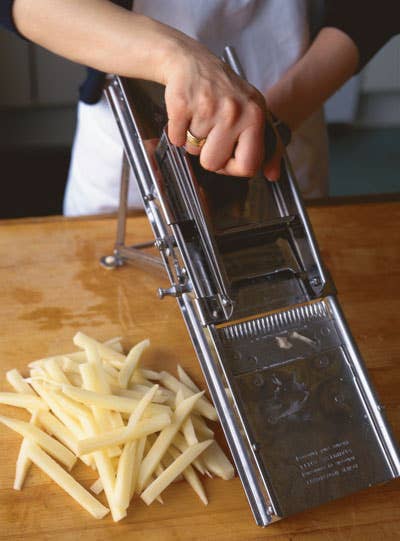
The Art of Making French Fries
Making french fries isn't complicated, but success depends on the understanding of some basic principles and precise techniques.
The Potato:
Start with good starchy ones, such as Idahos (also known as russets). For classic fries, peel the potatoes just before slicing, then place in water to cover.
The Oil:
We like the clean, faintly nutty flavor of peanut oil for our fries, but olive oil and other vegetable oils work well, too–as do lard and rendered beef fat, if you (or your arteries) dare.
The Knife:
Using a sharp chef’s knife, shape peeled potatoes into blocks. To hand-cut fries, slice the potatoes evenly lengthwise, then cut slices into fry-shaped pieces. If the potato sticks to the knife as you cut, wipe the blade or run it under water.
The Soak:
To keep cut potatoes from turning brown, place them in a nonreactive bowl and cover with water. For crispier fries, refrigerate soaking potatoes for two hours.
The Blot:
Before frying, dry potatoes thoroughly by blotting them with paper towels. Wet potatoes splatter and cook unevenly.
The Plunge:
Fries should be fried twice: once to cook, once to crisp. Don’t waste your money on special fryers; the only equipment you need is a heavy pot and a thermometer. Precise temperatures are vital; make sure the oil is at 325¿ for the first fry.
The Cooldown:
After the first fry, drain potatoes on paper towels and let them cool completely. At this point, they can be covered and refrigerated for later finishing.
The Second Plunge:
The second fry, at 375¿, crisps the potatoes. Again, check oil temperature with a thermometer.
The Results:
Remove fries from oil with a slotted spoon, drain on paper towels, sprinkle with salt, and serve. Classic fries, unlike potato chips, taste best when eaten immediately, while they’re still hot and crisp.
Keep Reading
Continue to Next Story










